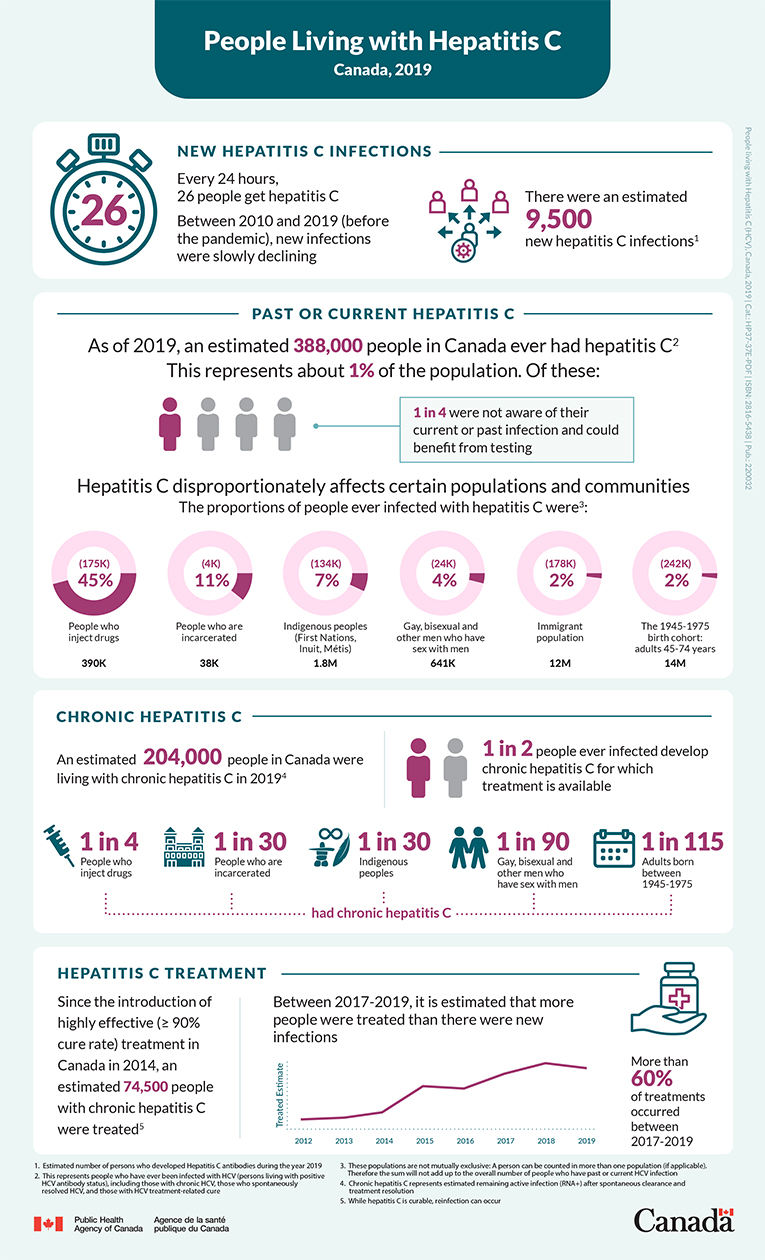People living with Hepatitis C (HCV) in Canada, 2019
Download in PDF format
(165 KB, 1 page)
Organization: Public Health Agency of Canada
Published: 2022-07-07
Cat.: HP37-37E-PDF
ISBN.: 2816-5438
Pub.: 220032
New Hepatitis C Infections
- Every 24 hours, 26 people get hepatitis C
- Between 2010 and 2019 (before the pandemic), new infections were slowly declining
- There were an estimated 9,500 new hepatitis C infectionsFootnote 1
Past or Current Hepatitis C
- As of 2019, an estimated 388,000 people in Canada ever had hepatitis CFootnote 2
- This represents about 1% of the population. Of these:
- 1 in 4 were not aware of their current or past infection and could benefit from testing
- Hepatitis C disproportionately affects certain populations and communities. The proportions of people ever infected with hepatitis C wereFootnote 3:
- 45% (175K/390K): People who inject drugs
- 11% (4K/38K): People who are incarcerated
- 7% (134K/1.8M): Indigenous peoples (First Nations, Inuit, Métis)
- 4% (24K/641K): Gay, bisexual and other men who have sex with men
- 2% (178K/12M): Immigrant population
- 2% (242K/14M): The 1945-1975 birth cohort: adults 45-74 years
Chronic Hepatitis C
- An estimated 204,000 people in Canada were living with chronic hepatitis C in 2019Footnote 4
- 1 in 2 people ever infected develop chronic hepatitis C for which treatment is available
- People living with chronic hepatitis C among certain populations and communities:
- 1 in 4 People who inject drugs
- 1 in 30 People who are incarcerated
- 1 in 30 Indigenous peoples
- 1 in 90 Gay, bisexual and other men who have sex with men
- 1 in 115 Adults born between 1945-1975
Hepatitis C Treatment
- Since the introduction of highly effective (≥ 90% cure rate) treatment in Canada in 2014, an estimated 74,500 people with chronic hepatitis C were treatedFootnote 5
- Between 2017-2019, it is estimated that more people have been treated than there were new infections
- Since 2012, More than 60% of treatments occurred between 2017-2019
Footnotes
- Footnote 1
-
Estimated number of persons who developed Hepatitis C antibodies during the year 2019
- Footnote 2
-
This represents people who have ever been infected with HCV (persons living with positive HCV antibody status), including those with chronic HCV, those who spontaneously resolved HCV, and those with HCV treatment-related cure
- Footnote 3
-
These populations are not mutually exclusive: A person can be counted in more than one population (if applicable). Therefore the sum will not add up to the overall estimated number of people who have past or current HCV infection
- Footnote 4
-
Chronic hepatitis C represents estimated remaining active infection (RNA+) after spontaneous clearance and treatment resolution
- Footnote 5
-
While hepatitis C is curable, reinfection can occur
